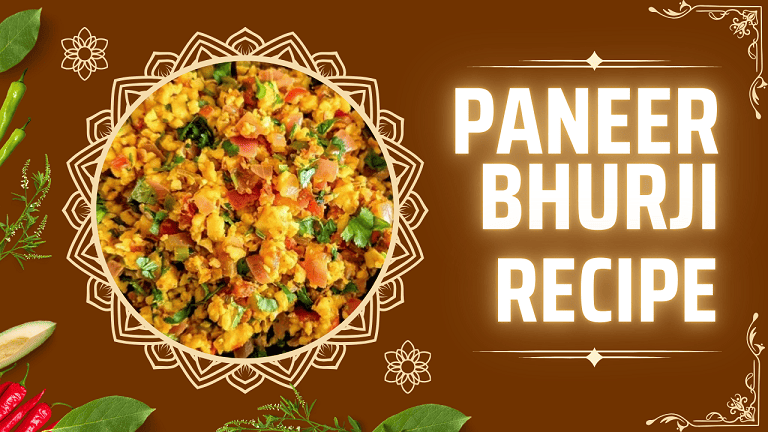Paneer Bhurji Recipe
Paneer, also known as Indian cottage cheese, is a versatile ingredient that plays a central role in vegetarian Indian cuisine.
Rich in protein, calcium, and healthy fats, it offers a myriad of health benefits, making it a popular choice among health-conscious individuals.
Paneer is also a favorite among vegetarians, providing a satisfying and hearty alternative to meat. This dish is not just nourishing but also packed with flavor, texture, and color, making it a perfect choice for family gatherings, celebrations, or simply a comforting meal at home.
Health Benefits of Paneer
High in Protein: Paneer is an excellent source of protein, essential for muscle growth and repair, making it a great addition to vegetarian diets.
Calcium-Rich: It helps in maintaining healthy bones and teeth, reducing the risk of osteoporosis.
Low in Carbohydrates: Paneer is low in carbs, making it suitable for low-carb and ketogenic diets.
Versatile: It can be cooked in various ways, making it adaptable to numerous cuisines.
The following is a delicious and nutritious Paneer Recipe that highlights the versatility of paneer while utilizing fresh, locally sourced ingredients commonly found in India.
Ingredients
For the Paneer Bhurji:
- Paneer: 250 grams, crumbled
- Onion: 1 medium-sized, finely chopped
- Tomato: 1 large, finely chopped
- Green chili: 1, slit (adjust according to taste)
- Ginger-garlic paste: 1 teaspoon
- Turmeric powder: 1/4 teaspoon
- Red chili powder: 1/2 teaspoon (optional)
- Garam masala: 1/2 teaspoon
- Coriander powder: 1/2 teaspoon
- Cumin seeds: 1/2 teaspoon
- Fresh coriander leaves: 2 tablespoons, chopped
- Oil: 2 tablespoons (preferably mustard oil for authenticity)
- Salt: to taste
Step-by-Step Instructions
Step 1: Preparing the Ingredients
Crumb the Paneer: Grate or crumble the paneer using your hands. Fresh, soft paneer works best for this recipe. If you are using refrigerated paneer, let it come to room temperature before crumbling.
Chop the Vegetables: Finely chop the onion and tomato. Slit the green chili and chop the coriander leaves.
Step 2: Cooking the Bhurji
Heat Oil: In a pan, heat the oil over medium heat. If you’re using mustard oil, heat until it smokes slightly, then lower the heat.
Sauté the Spices: Add cumin seeds to the hot oil. Once they start to splutter, add the finely chopped onions. Sauté until the onions turn translucent and slightly golden.
Add Ginger-Garlic Paste: Mix in the ginger-garlic paste and sauté for another minute until the raw smell disappears.
Tomatoes and Spices: Add the chopped tomatoes and green chili. Cook until the tomatoes soften. Add turmeric, red chili powder, coriander powder, and salt. Stir well and cook until the oil starts to separate from the mixture.
Mix in Crumbled Paneer: Gently add the crumbled paneer to the pan. Mix well to combine everything, ensuring the paneer is well coated with the spices.
Finish with Garam Masala: Sprinkle the garam masala and give it a final stir. Cook for an additional 2-3 minutes, allowing the flavors to meld together.
Garnish: Remove from heat and garnish with chopped coriander leaves.
Step 3: Serving Suggestions
Presentation: Serve the Paneer Bhurji hot, with a side of warm whole wheat chapatis or buttered toast. It can also be served with naan or parathas for a more filling meal.
Tips for Maximizing Flavor and Nutrition
Fresh Ingredients: Always use fresh, local ingredients. Fresh vegetables and paneer have better flavor and nutritional value.
Customize Spices: Feel free to adjust the spices according to your palate. Adding a pinch of ajwain (carom seeds) can enhance the flavor.
Balance Nutrients: Serve this dish with a side salad made of cucumbers, tomatoes, and onions to balance the meal with fiber and vitamins.
Healthy Fats: If you’re concerned about fat content, consider using low-fat paneer or preparing the dish with less oil. You can also use cooking spray to reduce oil usage.
Variations and Substitutions
Vegetable Additions: You can enhance the nutritional profile by adding finely chopped bell peppers, peas, or carrots to the bhurji.
Herbs and Greens: Experiment by adding spinach or methi (fenugreek leaves) for an extra boost of vitamins.
Spice Levels: If you prefer a milder dish, reduce the number of green chilies or use sweet bell peppers.
Gluten-Free Option: Serve with gluten-free alternatives like millet rotis or rice.
Cultural Significance
Paneer holds a special place in Indian cuisine, often being a centerpiece in various festive occasions. It is not only popular for its flavor and versatility but also symbolizes warmth and hospitality.
Paneer dishes like Bhurji are often prepared during gatherings and celebrations, representing togetherness and shared joy. This recipe, like many others, allows for creativity and personalization, making it a cherished part of many family traditions.
Conclusion
Incorporating fresh, locally sourced ingredients into your cooking not only enhances the flavors but also promotes sustainability and health. This Paneer Bhurji recipe is a testament to the wholesome goodness of paneer, offering a nutritious, satisfying meal that can be enjoyed by everyone.
Serving Tips
Accompaniments: Pair your Paneer Bhurji with mint chutney or yogurt for a refreshing contrast.
Garnishing: For an attractive presentation, serve in a colorful dish and sprinkle some additional fresh coriander or finely chopped onions on top.
Serving Style: Consider serving this dish family-style in a large bowl, allowing guests to help themselves and enjoy the meal together.
This delicious Paneer Bhurji is not just a meal but an experience—a blend of taste, culture, and nutrition that brings people together. Enjoy preparing and relishing this delightful dish!
Thanks for visiting Veg Recipe

